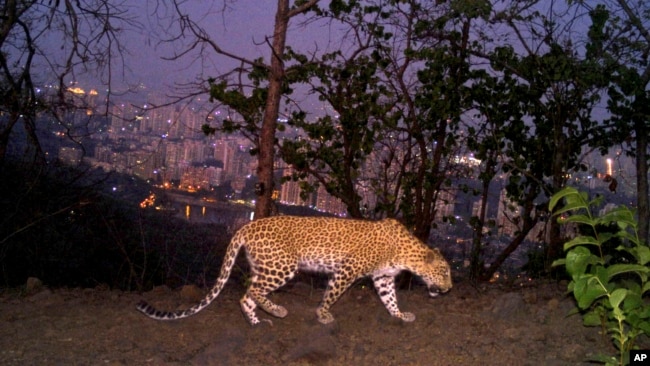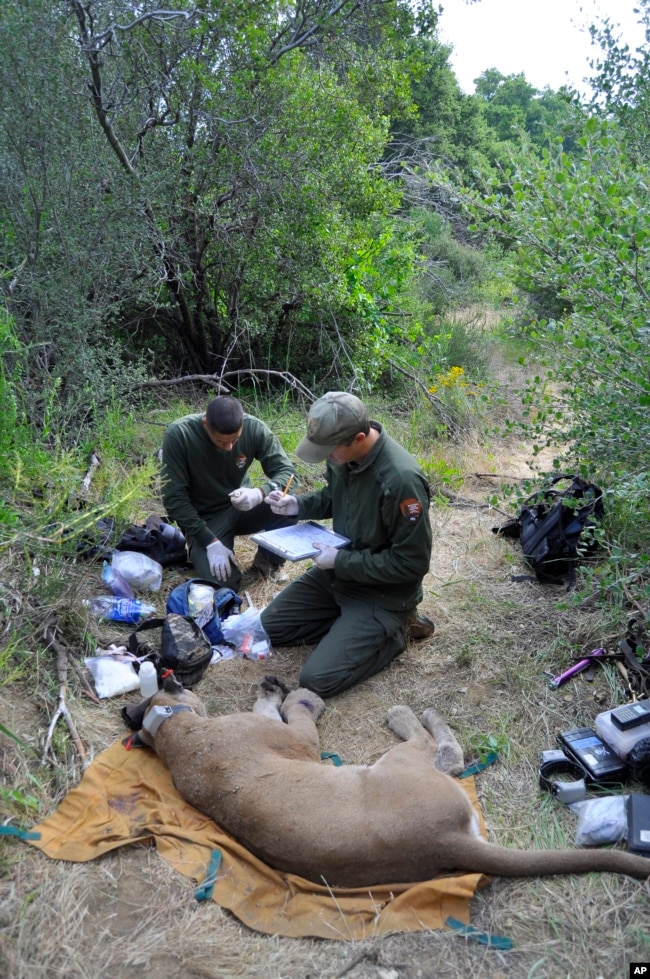Wow!! 恥ずかしがり屋なBig Catの保護計画
”These big cats are shy and really extreme introverts of the animal kingdom.!!”
愛すべきcreatures!!
VOAで英語を学びましょう!!
使ってみたいフレーズ:He was reasonably old.
ムンバイ、ロサンゼルス:大きな猫がいる2つの都市(和訳)
Mumbai, Los Angeles: Two Cities with Large Cats
July 03, 2022

インド、ムンバイ市を見下ろすサンジャイ・ガンジー国立公園近くのアーレイ・コロニーで、尾根を歩いているヒョウの姿
カリフォルニア州ロサンゼルスとインドのムンバイは、どちらも映画や洋服、交通の便で有名な都市です。しかし、この2つの大都市にはもう一つ共通点があります:それは、大型のネコ科動物が生息していることです。
ロサンゼルスとムンバイは、大型ネコ科動物—一方はマウンテンライオン、もう一方はヒョウ—が生息する世界で唯一の大都市です。しかし、カリフォルニア大学ロサンゼルス校の生物学者オードラ・ハフマイヤー氏は、「今後、都市部が自然の生息地をさらに侵食することで、このような都市が増えることになる。」と予測します。
ロサンゼルス
20年前、ロサンゼルスの科学者たちは、サンタモニカ山地という都市に隣接する地域からやってきた大きな雄のマウンテンライオンに追跡用の首輪を取り付けました。この大きな猫はP1と名付けられました。
GPSとカメラトラップで、科学者たちは7年間P1を追跡しました。国立公園局のセス・ライリー氏もその一人です。ライリー氏によると、P1について分かったのは2009年が最後だったそうです。
「喧嘩でもしたに違いありません。岩の上に彼の首輪と血痕を見つけました。そして、それ以来、彼の姿を見ることはありませんでした。それなりに歳をとっていたんです。」とライリー氏は言います。
それ以来、ライリー氏はロサンゼルスでさらに約100頭のマウンテンライオンに首輪をつける手伝いをしてきました。ロサンゼルス地域の大型ネコ科動物は、人間の死者を出していませんが、2021年に子供を襲った記録が1件あります。
マウンテンライオンにとって最大の脅威は、inbreeding近親交配– 同じファミリーメンバ間の交配–であることが判明しています。高速道路に挟まれた小さなテリトリーで生活しているため、一部のオスは娘や孫娘と交尾してしまうのだそうです。その結果、生殖能力の問題や変わった尻尾など、遺伝的な問題が生じています。
 2011年6月4日、サンタモニカ山国立保養地にて、P-21と呼ばれるオスのマウンテンライオンを捕獲。(AP通信による国立公園局)
2011年6月4日、サンタモニカ山国立保養地にて、P-21と呼ばれるオスのマウンテンライオンを捕獲。(AP通信による国立公園局)
ムンバイ
世界で最も人口密度の高い都市の1つであるムンバイでは、20頭分のスペースに約50頭のヒョウが暮らしています。しかし、この大型ネコ科動物はほとんど人目に触れることはありません。
インドの野生生物保護協会のディレクター、ヴィディヤ・アスレイヤ氏はこう語ります。「この動物はとても秘密主義なので、彼らのことはあまり分かっていません。観察すらできないんです。」とアスレイヤ氏は言います。
ヒョウの主な生息地はサンジャイ・ガンジー国立公園を中心とする地域です。この保護区の三方は人に囲まれており、その中には10万人の人と10頭前後のヒョウが生息している地域もあります。
ムンバイのヒョウは、主に森の外のゴミ捨て場へ行く野犬を狩っていました。追い詰められたり、襲われたりすると、人を襲うことがほとんどでした。しかし、2010年にはムンバイで20人がヒョウに襲われて死亡したと、ムンバイの保護林の職員であるジャガンナート・カンブル氏は言います。
 2013年7月10日、サンタモニカ山国立保養地内の道路を横切るマウンテンライオンP-23。(APによる国立公園局)
2013年7月10日、サンタモニカ山国立保養地内の道路を横切るマウンテンライオンP-23。(APによる国立公園局)
大型ネコ科動物にどう対処するか?
マウンテンライオンを研究するハフマイヤー氏は、「この地球上に大型carnivores肉食動物を存続させたいなら、彼らとの共存を学ばなければなりません。」 と話します。
※carnivores:【kɑ́rnəvɔ̀r 】
両都市とも、猫を捕獲したり殺したり、生息地から遠ざけたりすることは解決策にならないことを学びました。
ムンバイでは、2011年にボランティアや非政府グループ、メディアを巻き込んだ啓蒙活動を行いました。それ以来、死亡者数は減少し、2017年以降、ヒョウに襲われて死亡した者はいません。
ロサンゼルスでは、限られたテリトリーによる被害を示す研究が、市内で最も交通量の多いフリーウェイの1つである米国国道101号線に野生動物横断橋を建設するキャンペーンを後押ししました。
4月22日から建設が始まりました。3年後の完成時には、橋は在来種の植物で覆われ、通過する動物たちのために光と騒音を軽減する特別な防音壁が設置される予定です。サンタモニカ山地とシミ・ヒルズが結ばれ、マウンテンライオンの生息域が拡大されます。
National Wildlife Federationのカリフォルニア担当ディレクター、ベス・プラット氏は、「移転や殺処分は紛争を悪化させます。 」と述べています。回避することが最も安全な戦略である、と彼女は言います。
「この大きな猫は恥ずかしがり屋で、人との接触をできるだけ避ける傾向があります。動物界では極端な内向的なのです。」
Mumbai, Los Angeles: Two Cities with Large Cats
Los Angeles, California, and Mumbai, India, are both famous for movies, clothing, and traffic. But the two large cities are similar in another way: large cats live in and around them.
Los Angeles and Mumbai are the world’s only major cities where large cats— mountain lions in one, leopards in the other — live. But Audra Huffmeyer, a biologist at the University of California, Los Angeles, predicted, “In the future, there’s going to be more cities like this, as urban areas further encroach on natural habitats.”
Los Angeles
Twenty years ago, scientists in Los Angeles placed a tracking collar on a large male mountain lion that was from Santa Monica Mountains, an area next to the city. They named the big cat P1.
With GPS and camera traps, the scientists followed P1 for seven years. Seth Riley of the National Park Service was part of the effort. Riley said 2009 was the last time they learned about P1.
“There must have been a fight. We found his collar, blood on a rock. And never saw him again. He was reasonably old,” Riley said.
Since then, Riley has helped put collars on around 100 more mountain lions in Los Angeles. The big cats in the Los Angeles area have not caused any human deaths but recorded one attack on a child in 2021.
The biggest threat to mountain lions turns out to be inbreeding – mating between members of the same family. Living in small territories separated by highways has caused some males to mate with daughters and granddaughters. That has led to genetic problems such as fertility issues and unusual tails.
Mumbai
In Mumbai, one of the world’s most densely populated cities, about 50 leopards have lived in a space suited for 20. Yet the big cats keep mostly out of sight.
Vidya Athreya is the director of the Wildlife Conservation Society in India. “Because these animals are so secretive, you don’t know much about them. You can’t just observe them,” Athreya said.
The leopards’ main area is centered around Sanjay Gandhi National Park. The protected area is surrounded on three sides by people, including an area that is home to 100,000 people and around ten leopards.
Leopards in Mumbai mainly hunted wild dogs that go to garbage dumps outside the forest. They mostly attacked people when cornered or attacked. But in 2010, 20 people in Mumbai died in leopard attacks, said Jagannath Kamble, an official at Mumbai’s protected forest.
How to deal with big cats?
Huffmeyer, who studies mountain lions, said, “If we want to keep these large carnivores around on the planet, we have to learn to live with them.”
Both cities have learned that trying to capture, kill or move the cats away from their habitats is not the answer.
In Mumbai, officials involved volunteers, nongovernmental groups and the media in a public education program in 2011. Since then, deaths have dropped, and no one has been killed in a leopard attack since 2017.
In Los Angeles, research showing the harm caused by limited territories helped fuel a campaign to build a wildlife crossing bridge over U.S. Route 101, one of the city’s busiest freeways.
The building began on April 22. When it is finished in three years, the bridge will be covered in native plants and include special sound walls to reduce light and noise for the passing animals. It will connect the Santa Monica Mountains and Simi Hills, enlarging the area for mountain lions.
Beth Pratt, a California director at National Wildlife Federation, said, “Relocation and killing make conflict worse.” Avoidance is the safest strategy, she said.
“These big cats are shy — they tend to avoid human contact as much as they can. They’re really extreme introverts of the animal kingdom.”
Words in This Story
encroach -- v. to gradually take or begin to use or affect something that belongs to someone else or that someone else is using — usually + on or upon
habitat -- n. the place or type of place where a plant or animal naturally or normally lives or grows
track -- v. to follow and try to find (an animal) by looking for its tracks and other signs that show where it has gone
collar – n. a band of leather, plastic, etc., worn around an animal's neck
carnivore – n. an animal that eats meat
relocate - v. o move to a new place
shy -- adj. tending to avoid something because of nervousness, fear, dislike, etc.
introvert – n. a shy person : a quiet person who does not find it easy to talk to other people